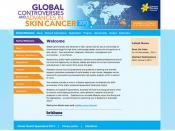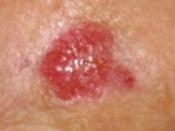According to the American Academy of Dermatology (2011), "There are over two million new cases of skin cancer diagnosed in the U.S. each year, outnumbering all other cancers combined." Although most cases of skin cancer can be treated successfully if found early, the growing number of people getting skin cancer makes the disease a serious concern. Skin cancer can occur on both healthy skin and damaged skin tissues, and can develop rapidly after its initial appearance on the skin. Types of skin cancer include basal cell carcinoma, squamous cell carcinoma, and melanoma. Basal cell carcinoma is the most common type of skin cancer, and accounts for about 80 to 90 percent of all skin cancer cases in the United States (Types of skin cancer, 2010). According to the American Academy of Dermatology (2011), squamous cell carcinoma affects approximately 200,000 people in the United States every year. Melanoma is the most rare type of skin cancer but also the most deadly; it accounts for 75 percent of all deaths from skin cancer.
(Types of skin cancer, 2010). The development of basal cell carcinoma, squamous cell carcinoma, and melanoma can affect people of all ages and skin types, but some people are genetically more at risk than others. The incidence of skin cancer does increase with age. Squamous and basal cell carcinomas typically affect adults over the age of 40, and are more common in males than females. Melanoma is more predominant in younger individuals. Melanoma peaks between 20 and 45 years of age (Skin cancer, 2011). Although if melanoma is found in the older adult, it is usually diagnosed in a later stage and is more likely to be lethal. Risk factors for skin cancer include having fair skin that develops freckles easily, a history of sunburns, excessive sun exposure,


